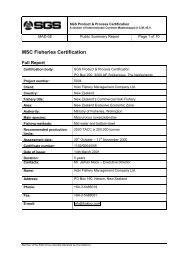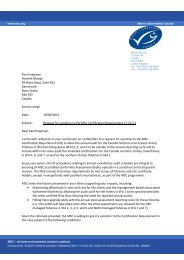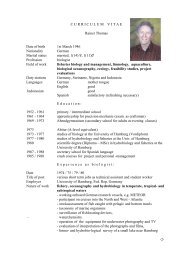SGS Product & Process Certification - Marine Stewardship Council
SGS Product & Process Certification - Marine Stewardship Council
SGS Product & Process Certification - Marine Stewardship Council
Create successful ePaper yourself
Turn your PDF publications into a flip-book with our unique Google optimized e-Paper software.
Scoring criteria Scoring guidepost 60 Scoring guidepost 80 Scoring guidepost 100<br />
2.1.2 Management<br />
strategy: There is a<br />
strategy in place for<br />
managing retained<br />
species that is<br />
designed to ensure<br />
the fishery does not<br />
pose a risk of serious<br />
or irreversible harm to<br />
retained species.<br />
(1-60) There are measures in<br />
place, if necessary, that are<br />
expected to maintain the main<br />
retained species at levels which<br />
are highly likely to be within<br />
biologically based limits, or to<br />
ensure the fishery does not<br />
hinder their recovery and<br />
rebuilding.<br />
(2-60) The measures are<br />
considered likely to work, based<br />
on plausible argument (e.g.,<br />
general experience, theory or<br />
comparison with similar<br />
fisheries/species).<br />
(1-80) There is a partial strategy<br />
in place, if necessary that is<br />
expected to maintain the main<br />
retained species at levels which<br />
are highly likely to be within<br />
biologically based limits, or to<br />
ensure the fishery does not<br />
hinder their recovery and<br />
rebuilding.<br />
(2-80) There is some objective<br />
basis for confidence that the<br />
partial strategy will work, based<br />
on some information directly<br />
about the fishery and/or species<br />
involved.<br />
(3-80) There is some evidence<br />
that the partial strategy is being<br />
implemented successfully.<br />
(1-100) There is a strategy in<br />
place for managing retained<br />
species.<br />
(2-100) The strategy is mainly<br />
based on information directly<br />
about the fishery and/or species<br />
involved, and testing supports<br />
high confidence that the strategy<br />
will work.<br />
(3-100) There is clear evidence<br />
that the strategy is being<br />
implemented successfully, and<br />
intended changes are occurring.<br />
(4-100) There is some evidence<br />
that the strategy is achieving its<br />
overall objective.<br />
Scoring comments<br />
There is an EU Norway recovery plan for cod that was updated in 2008, when a long-term management plan for this stock was adopted (<strong>Council</strong><br />
Regulation (EC) 1342/2008). Thus, there is a partial strategy in place that is expected to ensure the UoC fishery does not hinder the recovery<br />
and rebuilding of North Sea cod. The rules in the long-term management plan have been implemented through the TACs set by the European<br />
Commission, and there is evidence that the fishing mortality has been reduced<br />
ICES evaluated both plans in 2009 and concluded they are in accordance with the precautionary approach if implemented and enforced<br />
adequately. Therefore, there is some objective basis for confidence that the partial strategy will work, based on information directly about the<br />
fishery and/or species involved.<br />
Page 72 of 151





